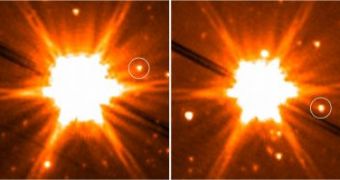Astronomers using NASA's Spitzer Space Telescope have discovered a brown dwarf orbiting a Sun-like star, the first such discovery insofar although these types of systems might be quite common.
Brown dwarfs are the smallest stars - sometimes called failed stars. Their masses are between around 13 to 80 times larger than Jupiter's (our Sun is about 1000 times more massive than Jupiter). Their mass is not sufficiently large to maintain a normal sustainable fusion reaction (fusing hydrogen to form helium) but nonetheless, some fusion reactions do occur (between lithium and deuterium) and thus, they emit some light - unlike gas giant planets like Jupiter.
However, their surface temperature is only a few thousands of degrees when young, and it cools considerably as they age. Consequently, they are dim and hard to identify and, as a result, the first unambiguous identification came only about ten years ago. It is often difficult to know whether the observed object is a brown dwarf or a giant gas planet.
The brown dwarf discovered by the team led by Kevin Luhman from Penn State University Department of Astronomy and Astrophysics is 50 times the mass of Jupiter and orbits a star slightly smaller than our Sun located in the constellation Pisces. The brown dwarf belongs to the class of the coldest brown dwarfs, called T dwarfs.
"Over the last ten years, astronomers have been extremely successful in finding planets close to their host stars using indirect detection methods," said Luhman. "Because of its infrared capabilities, Spitzer is well suited for directly detecting cool T dwarfs, and perhaps even large planets, in the outer parts of planetary systems."
The system also contains a planet slightly smaller than Saturn and relatively close to the star but having a highly distorted orbit. This is what attracted the attention of the astronomers in the first place as they suspected there should be another object pulling the planet outward. The Saturn-mass planet was discovered through Doppler observations in 2003.
"The orbit of the planet in this system is similar to Mercury's, but the T dwarf has an orbit over ten times larger than Pluto's," said co-author Brian Patten of the Harvard-Smithsonian Center for Astrophysics. "Although HD 3651 B would be just beyond naked-eye visibility to an intrepid astronomer living on this system's planet, the T dwarf makes its presence known through gravity."
Many extrasolar planets discovered so far have highly elliptical orbits. The Spitzer discovery is the first evidence to support the theory that small companions such as T dwarfs can hide in such solar systems and can cause the orbits of planets to be extreme.
Luhman's team also discovered a second brown dwarf that is even smaller, about 20 times the mass of Jupiter, orbiting another star, HN Peg. This discovery is also very interesting because this star seems to be very young, only about 300 million years old, and thus it offers a snapshot of early brown-dwarf development. This star system is so young that it still has a debris disk that will eventually aggregate into planets.
"Detectable debris disks and T dwarf companions are fairly rare, so the presence of both around the same star makes this a particularly exciting star system," said co-author Giovanni Fazio also from the Harvard-Smithsonian Center for Astrophysics.
After finding these two brown dwarfs, Spitzer has also discovered another one floating through space by itself. The team that discovered that T dwarf is led by Daniel Stern at NASA's Jet Propulsion Laboratory.

 14 DAY TRIAL //
14 DAY TRIAL //